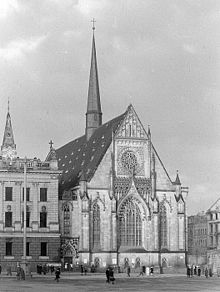Paulinerkirche, Leipzig
| Paulinerkirche | |
|---|---|

The Paulinerkirche, the university church of Leipzig, view from the Augustusplatz, 1948, facade of Arwed Roßbach
|
|
| Location | Leipzig |
| Country | Germany |
| Denomination | Lutheran |
| Previous denomination | Catholic |
| History | |
| Dedication | St. Paul (when Catholic) |
| Architecture | |
| Style | Gothic |
| Groundbreaking | 1229 |
| Completed | 1231 |
| Demolished | 30 May 1968 |
The Paulinerkirche was a church on the Augustusplatz in Leipzig, named after the "Pauliner", its original Dominican friars. It was built in 1231 as the Klosterkirche St. Pauli for the Dominican monastery in Leipzig. From the foundation of the University of Leipzig in 1409, it served as the university church. After the Protestant Reformation it was donated to the university and was inaugurated in 1545 by Martin Luther as the Universitätskirche St. Pauli (University Church of St Paul), later also called Unikirche. Johann Sebastian Bach was director of music for "festal" (holiday) services in 1723−25.
The church survived the war practically unscathed but was dynamited in 1968 during the communist regime of East Germany. After the reunification of Germany, it was decided to build a new university church on the site in the shape of the former church. A new building, the Paulinum (formally: "Aula und Universitätskirche St. Pauli", i.e. "Assembly Hall and University Church St. Paul"), was built on the site beginning in 2007.
In 1229, friars of the Dominican Order settled in Leipzig and started building the Paulinerkirche in 1231 as their abbey church, within the city walls close to the gate "Grimmaisches Tor". It was built in the typical fashion of a church of a Mendicant order of the 13th century, with a choir and a nave with two aisles in the "Langhaus". The church was consecrated in 1240 by archbishop Wilbrand from Magdeburg to St. Paul.
Since the foundation of the University of Leipzig in 1409, the church was closely related to the university. A tradition of "Universitätsgottesdienst" (university service) started then, with preachers appointed by the university since 1419. The altar from the 15th century is now in the Thomaskirche. Several faculty members of the university and their relatives were buried in the church, commemorated on epitaphs of artistic value, people such as Johann Christoph Marci (law), Christian Friedrich Franckenstein (historian) and Benedikt Carpzov (1595-1666, law), whose epitaph was restored in 2011.Johann Tetzel, a Dominican preacher famous for selling indulgences, was buried in 1517.
...
Wikipedia
